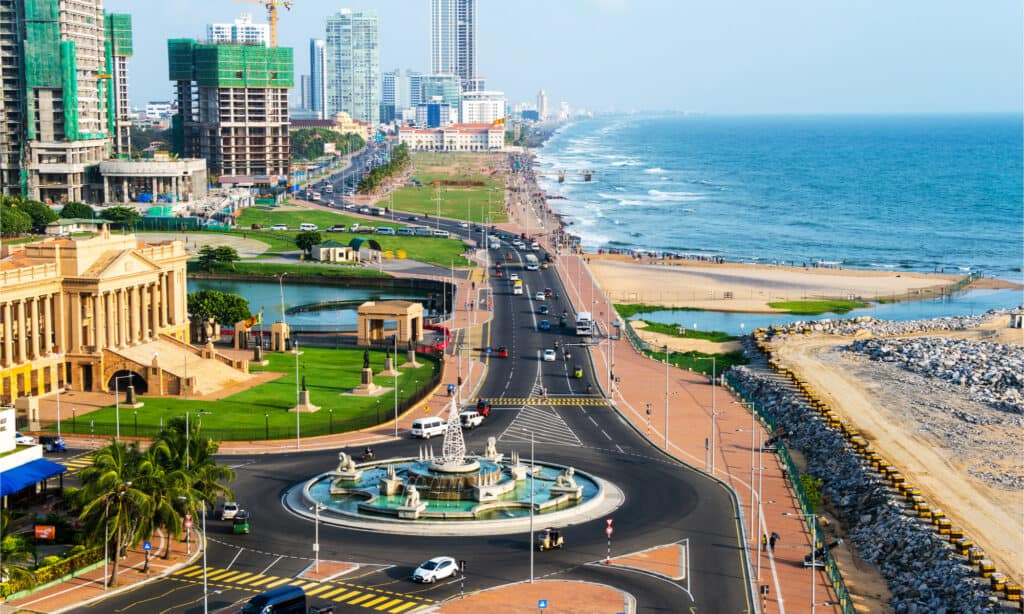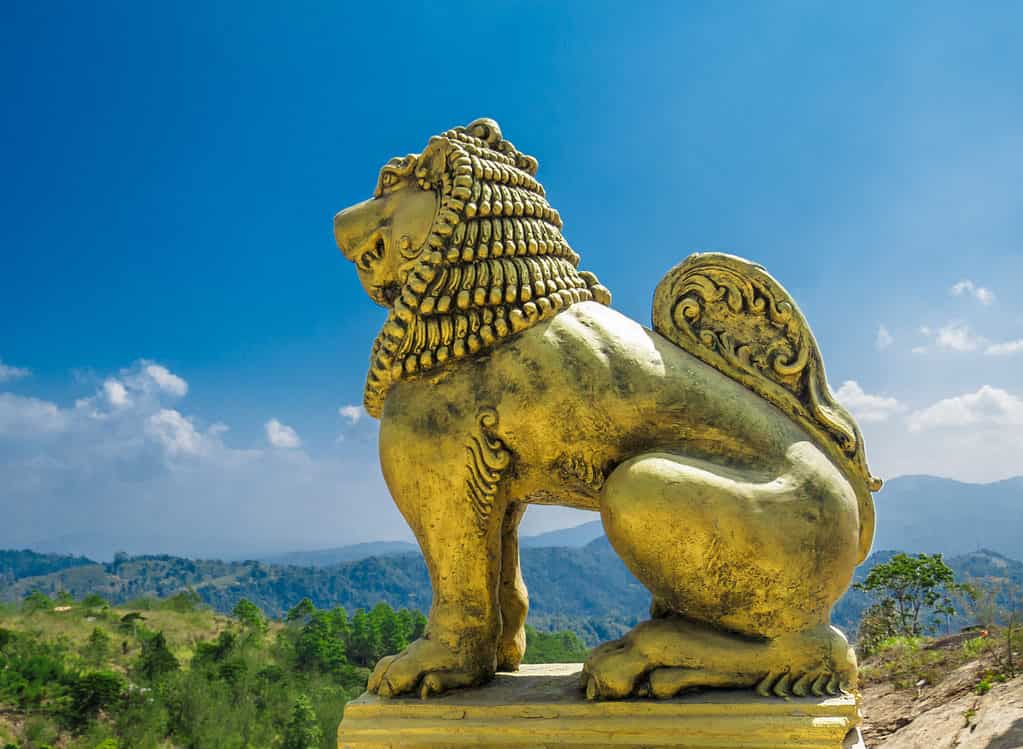Sri Lanka is a beautiful island county in South Asia filled with diverse cultures and lots to see. Sri Lanks also has nicknames, such as “Pearl of the Indian Ocean,” “Teardrop of India,” and “Land of Serendipity.” Its flag is just as beautiful and full of meaning. Follow along to learn more about the flag of Sri Lanka, including its history and symbolism.
Where is Sri Lanka?
Sri Lanka is an island county located in South Asia, specifically, the Indian Ocean. It’s southwest of the Bay of Bengal. Sandwiched between the Bay of Bengal and the Laccadive Sea, this island country is only 19 miles away from the southern coast of India. Sri Lanka is made up of one main island and other smaller islands.

Aerial view of Colombo, the executive and judicial capital of Sri Lanka, and largest city by population.
©Madrugada Verde/Shutterstock.com
A Brief History of Sri Lanka
Although Sri Lanka has a long and vibrant history, we are only going to dive into a brief summary for some background to understand the country’s flag better. The history of the country first starts with the first signs of human colonization in the region. Experts found evidence of human colonization in Sri Lanka at the site of Balangoda. It’s thought that the first people to arrive in Sri Lanka were Balangoda Man about 125,000 years ago. They lived in caves and were Mesolithic hunter-gatherers.
Modern European Intervention
Long before modern European intervention, the Anuradhapura Kingdom, Kingdom of Polonnaruwa, Jaffna Kingdom, Kingdom of Dambadeniya, Kingdom of Gampola, Kingdom of Kotte, Kingdom of Sitawaka, and the Vannimai ruled the region.
However, in 1505, the Portuguese, led by Lourenço de Almeida, arrived on the island. The Portuguese fought against the seven warring kingdoms and built a fort in 1517 to gain control over the coastal areas. The Sinhalese and the Portuguese fought throughout the 16th century. To get rid of the Portuguese, the king of Kady, Rajasinghe II, struck a deal with the Dutch. Although a treaty was in place, both sides breached the agreement and the Dutch pushed the Portuguese out, gaining control over most of the island and implementing higher taxes.
Colonial Sri Lanka
Before colonial Sri Lanka, the kingdom of Kandy reigned from 1594 to 1815. The monarchy, however, didn’t end until 1832, when the last king, Sri Vikrama Rajasinha, died. Great Britain afterward occupied the coastal areas of Sri Lanka during the Napoleonic Wars. They feared the island would be delivered to France. Instead, it became a British crown colony. During this time, there was a lot of conflict between Great Britain and the Kingdom of Kandy. Sri Lankan independence ended in 1815 after the second Kandyan War.
Sri Lanka Independence
The independence movement for Sri Lanka sparked for many reasons, including the rise of Ceylon’s elite. Many groups, parties, and organizations were formed, like Youth Leagues and the Marxist Lanka Sama Samaja Party. Sri Lanka gained its independence from Great Britain on February 4, 1948, after a 400-year colonial era. The country was first named the Dominion of Ceylon. The new country retained dominion status within the British Commonwealth until 22 May 1972. This is when the country became a republic and changed its name to the Republic of Sri Lanka.
The Flag of Sri Lanka
The flag of Sri Lanka is vibrant, bright, and beautiful. It has a golden field or background with two panels. The panel on the left side of the flag has two stripes of color, teal and orange. On the other side is a larger panel with a maroon background. On the maroon-red background is a golden lion holding the kastane sword in its right forepaw. There are also four bo tree leaves on the right panel, one in each corner.
Sri Lanka’s flags were redesigned multiple times. However, the most recent edition was adopted as a national flag in 1972 with the guidance of Nissanka Wijeyeratne, Permanent Secretary to the Ministry of Cultural Affairs and Chairman of the National Emblem and Flag Design Committee. Most of the previous flags used to represent the region in its many kingdoms used a golden lion.
There is a lot of meaning behind the symbolism and colors of Sri Lanka’s current flag. For example, the use of the golden lion dates back to 486 BC. It symbolizes the strength of the nation and the Sinhala ethnicity. The bo tree leaves represent the four Buddhist virtues. The sword the lion holds symbolizes the sovereignty of the nation. Even small design features on the lion have meaning. For instance, the beard represents the purity of words, while the eight hairs on the lion’s tail acknowledge the Noble Eightfold Path. Concerning colors, maroon was selected to honor the Sinhala ethnicity. The teal stripe represents the Moor ethnicity, while the orange vertical stripe represents Tamil ethnicity.

The Sinhalese—the primary ethnic group of Sri Lanka—revere lions so much that they call themselves the “lion people.”
©ThePhotographerSL/Shutterstock.com
The photo featured at the top of this post is © Pixfiction/Shutterstock.com
Thank you for reading! Have some feedback for us? Contact the AZ Animals editorial team.







